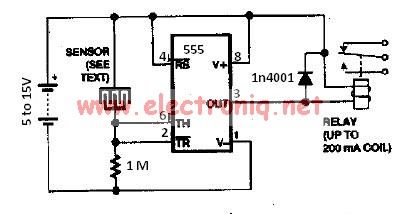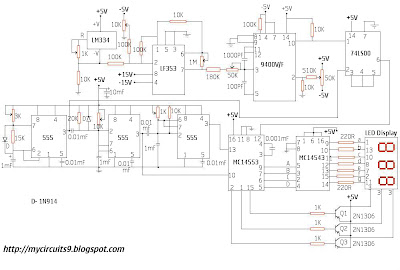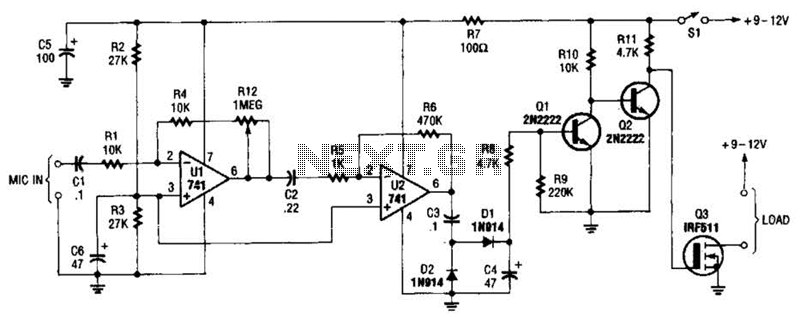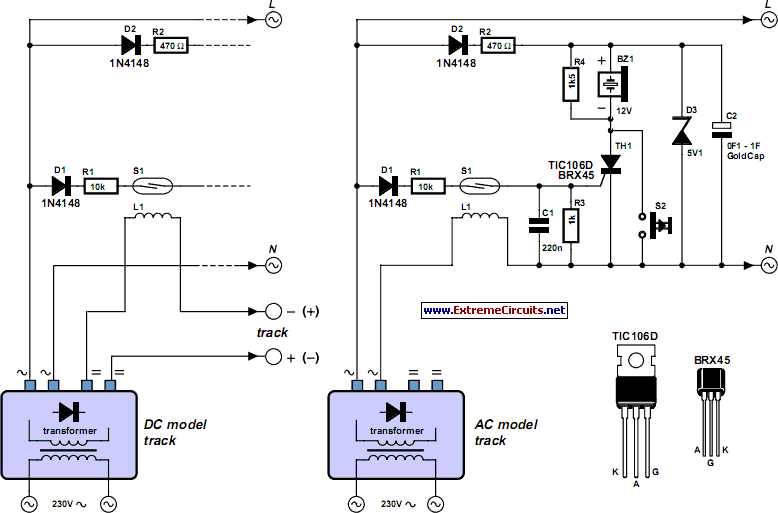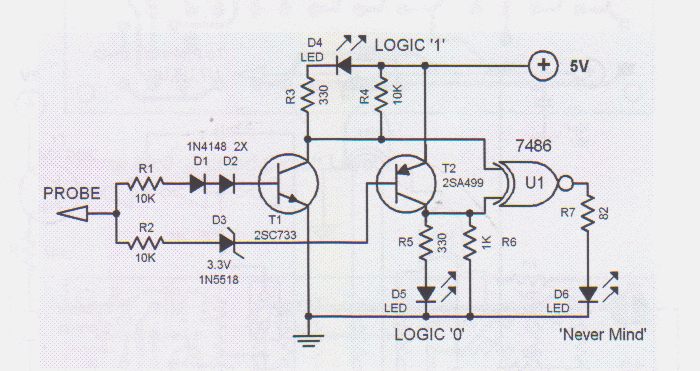
Computer Microphone Circuit

This circuit was designed by Lazar Pancic from Yugoslavia. A typical PC sound card includes a microphone input, speaker output, and occasionally line inputs and outputs. The microphone input is specifically tailored for dynamic microphones with an impedance range of 200 to 600 ohms. Lazar has modified the sound card to accommodate a common electret microphone using this circuit. He has created a composite amplifier utilizing two transistors. The circuit operates on the principle that the BC413B transistor functions in a common emitter configuration to provide a slight amplification of the microphone signal. This is followed by an emitter follower stage using the BC547C transistor. This stage is essential because the microphone, circuit, and battery will be located at a distance from the sound card. The low output impedance of the circuit, combined with a screened cable, ensures a clean signal with minimal noise interference.
The circuit design involves a composite amplifier configuration that effectively enhances the performance of an electret microphone when interfacing with a PC sound card. The primary component, the BC413B transistor, is configured in a common emitter arrangement, which is known for its ability to amplify weak signals. This configuration increases the voltage gain, allowing the low-level audio signal from the electret microphone to be boosted sufficiently for processing by the sound card.
Following the amplification stage, the BC547C transistor is employed as an emitter follower. This configuration is crucial for impedance matching; it provides a high input impedance while maintaining a low output impedance. This characteristic is particularly beneficial when the microphone and associated circuitry are situated away from the sound card, as it minimizes signal degradation over longer distances. The low output impedance also facilitates the use of shielded cables, which further reduces susceptibility to electromagnetic interference and ensures a clean, high-quality audio signal.
Overall, this circuit design exemplifies a practical approach to integrating an electret microphone with a PC sound card, enhancing audio capture capabilities while maintaining signal integrity. The careful selection of components and their configuration addresses common challenges in audio signal processing, making it a valuable addition to audio-related projects.This circuit was submitted and design by Lazar Pancic from Yugoslavia. The sound card for a PC generally has a microphone input, speaker output and sometimes line inputs and outputs. The mic input is designed for dynamic microphones only in impedance range of 200 to 600 ohms. Lazar has adapted the sound card to use a common electret microphone usi ng this circuit. He has made a composite amplifier using two transistors. This is the figure of the circuit. This is the explanation about the principle work of the circuit. The BC413B operates in common emitter to give a slight boost to the mic signal. This is followed by an emitter follower stage using the BC547C. This is necessary as the mic and circuit and battery will be some distance from the sound card, the low output impedance of the circuit and screened cable ensuring a clean signal with minimum noise pickup. 🔗 External reference
The circuit design involves a composite amplifier configuration that effectively enhances the performance of an electret microphone when interfacing with a PC sound card. The primary component, the BC413B transistor, is configured in a common emitter arrangement, which is known for its ability to amplify weak signals. This configuration increases the voltage gain, allowing the low-level audio signal from the electret microphone to be boosted sufficiently for processing by the sound card.
Following the amplification stage, the BC547C transistor is employed as an emitter follower. This configuration is crucial for impedance matching; it provides a high input impedance while maintaining a low output impedance. This characteristic is particularly beneficial when the microphone and associated circuitry are situated away from the sound card, as it minimizes signal degradation over longer distances. The low output impedance also facilitates the use of shielded cables, which further reduces susceptibility to electromagnetic interference and ensures a clean, high-quality audio signal.
Overall, this circuit design exemplifies a practical approach to integrating an electret microphone with a PC sound card, enhancing audio capture capabilities while maintaining signal integrity. The careful selection of components and their configuration addresses common challenges in audio signal processing, making it a valuable addition to audio-related projects.This circuit was submitted and design by Lazar Pancic from Yugoslavia. The sound card for a PC generally has a microphone input, speaker output and sometimes line inputs and outputs. The mic input is designed for dynamic microphones only in impedance range of 200 to 600 ohms. Lazar has adapted the sound card to use a common electret microphone usi ng this circuit. He has made a composite amplifier using two transistors. This is the figure of the circuit. This is the explanation about the principle work of the circuit. The BC413B operates in common emitter to give a slight boost to the mic signal. This is followed by an emitter follower stage using the BC547C. This is necessary as the mic and circuit and battery will be some distance from the sound card, the low output impedance of the circuit and screened cable ensuring a clean signal with minimum noise pickup. 🔗 External reference
